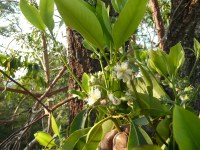Maclean Forest Linkages: High Conservation Corridors Restoration
New project granted funding approval August 2014
Maclean Landcare Group Inc. has an overall strategy to restore the native vegetation linkages within Maclean. All landholders have been contacted and ongoing planning and works are used to encourage more participation. Restoration work will build on achievments of Environmental Trust project 2008/RR/017 and the Landcare group's ongoing work in the Lookout Reserve by restoring adjoining areas. A second site restoration plan was compiled in 2012 . This project also extends primary weed control work Clarence Valley Council is undertaking on sections of the properties as part of a Clarence Valley Council Biodiversity Fund project.
The following species are likely to occur on the sites, and are listed as vulnerable under the Environment Protection and Biodiversity Conservation Act 1999 (EPBC Act):
Drynaria rigidula, a threatened flora species occurs on at least one of the properties.
Wompoo Fruit-dove (Ptilinopus magnificus) is listed as vulnerable.
Grey headed flying fox
Lower creek riparian areas contain Lowland Sub tropical rainforest which is recognised nationally as critically endangered and could be restored in some areas.
Weeds, predominately Lantana, Madeira Vine, Dutchmans Pipe and garden escapees, are threatening native vegetation communities. Loss and degradation of native plant and animal habitat by invasion of escaped garden plants is a EPBC listed Key Threatening Process (KTP). Invasion and establishment of exotic vines and scramblers and invasion, establishment and spread of Lantana are also KTP in NSW. These weeds compete with the native vegetation for resources and suppress native seedlings. Lantana and Maderia are Weeds of National Significance (WoNS). If nothing is done weed encroachment will continue to degrade native vegetation and habitat for threatened species.

Maclean Landcare, Clarence Valley Council, private landowners, Yaegl LALC and contractors will rehabilitate lowland rainforest & sclerophyll forest in the Lower Clarence Climate Coastal Connector Corridor at Maclean. Systematic bush regeneration works will control weed threats to habitat for threatened species. Ecological restoration will benefit fauna by improving access to habitat areas and feed trees. The project will improve habitat connections, vegetation extent and resilience and reduce weed impacts. This project also aims to improve restoration skills & biodiversity awareness among private landowners and the local community.


Restoration works are additional to what council, LALCs, landcare and private landholders are required to undertake. Effective control of environmental weeds needs a systematic community approach to ensure success and some species require specialist weed control techniques to manage. Landholders have made significant efforts to improve the environmental values of their properties.These landholders are committed to conserving the biodiversity on their properties.






